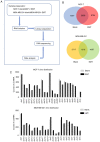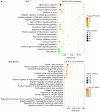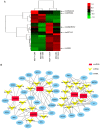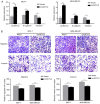EMT related circular RNA expression profiles identify circSCYL2 as a novel molecule in breast tumor metastasis
- PMID: 32236616
- PMCID: PMC7169655
- DOI: 10.3892/ijmm.2020.4550
EMT related circular RNA expression profiles identify circSCYL2 as a novel molecule in breast tumor metastasis
Abstract
Substantial evidence indicates that circular RNAs (circRNAs) play vital roles in several diseases, especially in cancer development. However, the functions of circRNAs in breast cancer metastasis remain to be investigated. This study aimed to identify the key circRNAs involved in epithelial mesenchymal transition (EMT) of breast cancer and evaluated their molecular function and roles in pathways that may be associated with tumor metastasis. An EMT model was constructed by treating breast cancer cells MCF‑7 and MDA‑MB‑231 with transforming growth factor‑β1. High‑throughput RNA sequencing was used to identify the differentially expressed circRNAs in EMT and blank groups of two cells, and reverse transcription‑quantitative PCR was used to validate the expression of circSCYL2 in human breast cancer tissues and cells. The effects of circSCYL2 on breast cancer cells were explored by transfecting with plasmids and the biological roles were assessed using transwell assays. EMT groups of breast cancer cells exhibited the characteristics of mesenchymal cells. Furthermore, the present study found that 7 circRNAs were significantly upregulated in both the MCF‑7 EMT and MDA‑MB‑231 EMT groups, while 16 circRNAs were significantly downregulated. The current study identified that circSCYL2 was downregulated in breast cancer tissues and cell lines, and that circSCYL2 overexpression inhibited cell migration and invasion. This study provides expression profiles of circRNAs in EMT groups of breast cancer cells. circSCYL2, which is downregulated in breast cancer tissues and cells, may play an important role in breast cancer EMT progression.
Figures









Similar articles
-
Circular RNA hsa_circ_0008305 (circPTK2) inhibits TGF-β-induced epithelial-mesenchymal transition and metastasis by controlling TIF1γ in non-small cell lung cancer.Mol Cancer. 2018 Sep 27;17(1):140. doi: 10.1186/s12943-018-0889-7. Mol Cancer. 2018. PMID: 30261900 Free PMC article.
-
Screening and identification of epithelial-to-mesenchymal transition-related circRNA and miRNA in prostate cancer.Pathol Res Pract. 2020 Feb;216(2):152784. doi: 10.1016/j.prp.2019.152784. Epub 2019 Dec 19. Pathol Res Pract. 2020. PMID: 31882179
-
Circular RNA hsa_circ_0004689 (circSWT1) promotes NSCLC progression via the miR-370-3p/SNAIL axis by inducing cell epithelial-mesenchymal transition (EMT).Cancer Med. 2023 Apr;12(7):8289-8305. doi: 10.1002/cam4.5527. Epub 2022 Dec 19. Cancer Med. 2023. PMID: 36530171 Free PMC article.
-
Circular RNAs: Emerging regulators of signaling pathways in epithelial-mesenchymal transition and angiogenesis during breast cancer progression.Semin Oncol. 2025 Apr;52(2):152340. doi: 10.1016/j.seminoncol.2025.152340. Epub 2025 Apr 11. Semin Oncol. 2025. PMID: 40220369 Review.
-
Functional roles of circular RNAs during epithelial-to-mesenchymal transition.Mol Cancer. 2019 Sep 16;18(1):138. doi: 10.1186/s12943-019-1071-6. Mol Cancer. 2019. PMID: 31526370 Free PMC article. Review.
Cited by
-
Circular RNAs Interaction with MiRNAs: Emerging Roles in Breast Cancer.Int J Med Sci. 2021 Jul 11;18(14):3182-3196. doi: 10.7150/ijms.62219. eCollection 2021. Int J Med Sci. 2021. PMID: 34400888 Free PMC article. Review.
-
The Regulation Network and Clinical Significance of Circular RNAs in Breast Cancer.Front Oncol. 2021 Jul 9;11:691317. doi: 10.3389/fonc.2021.691317. eCollection 2021. Front Oncol. 2021. PMID: 34307155 Free PMC article.
-
Assessing the impact of extracellular matrix fiber orientation on breast cancer cellular metabolism.Cancer Cell Int. 2024 Jun 5;24(1):199. doi: 10.1186/s12935-024-03385-3. Cancer Cell Int. 2024. PMID: 38840117 Free PMC article.
-
Circular RNAs in Breast Cancer: An Update.Biomolecules. 2024 Jan 29;14(2):158. doi: 10.3390/biom14020158. Biomolecules. 2024. PMID: 38397395 Free PMC article. Review.
-
Prospect of exosomal circular RNAs in breast Cancer: presents and future.Mol Biol Rep. 2022 Jul;49(7):6997-7011. doi: 10.1007/s11033-022-07472-4. Epub 2022 May 9. Mol Biol Rep. 2022. PMID: 35534582 Review.
References
-
- Rodgers RJ, Reid GD, Koch J, Deans R, Ledger WL, Friedlander M, Gilchrist RB, Walters KA, Abbott JA. The safety and efficacy of controlled ovarian hyperstimulation for fertility preservation in women with early breast cancer: A systematic review. Hum Reprod. 2017;32:1033–1045. doi: 10.1093/humrep/dex027. - DOI - PubMed
MeSH terms
Substances
LinkOut - more resources
Full Text Sources
Medical
Miscellaneous

